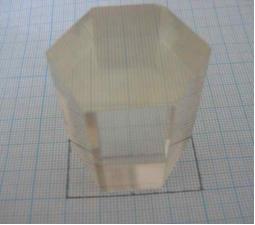|
Scintillators for cryogenic rare-event search experiments
Within several years of research we
have already identified a number of compounds that have good prospects
for cryogenic applications. The main scintillation properties of
investigated materials are listed in the table below. A comparison of the
light output of studied materials at 295 and 9 K is displayed in the
figure 1 to the right.
|
Crystal |
Density,
g/cm3 |
Emission peak, nm |
Decay time, micro seconds |
Light yield, (relative to CaWO4
@ 9K) |
Light yield, ph/MeV @ 295 K |
Resolution, % (137Cs) |
|
300 K |
9 K |
300 K |
9 K |
|
CaWO41,2 |
6.06 |
420 |
9 |
390 |
55 |
100 |
160003 |
6.63 |
|
ZnWO41,2 |
7.87 |
490 |
24 |
120 |
60 |
120 |
110004 |
10.75 9.66 |
|
MgWO47,8 |
5.66 |
480 |
36 |
90 |
30 |
40 |
130007 |
9.17 |
|
CaMoO49 |
4.35 |
540 |
10 |
630 |
30 |
95 |
89009 |
10.310 |
|
CdMoO42 |
6.07 |
550 |
- |
470 |
- |
80 |
|
|
|
Bi4Ge3O1211 |
7.13 |
|
0.43 |
138 |
45 |
150 |
690012 |
1012 |
|
Al2O3:Ti13 |
3.98 |
290
420
730 |
0.14
3 |
4 |
15 |
30 |
240013(0.20%)
750014(0.07%) |
|
|
CaF215 |
3.18 |
280 |
1 |
930 |
15 |
60 |
|
|
|
References:
|
1.
|
Feasibility study of a ZnWO4 scintillator for exploiting
materials signature in cryogenic WIMP Dark Matter searches,
H. Kraus et al.,Physics Letters B 610 (2005) 37.
|
|
2.
|
Cryogenic
scintillators in searches for extremely rare events, V. B.
Mikhailik and H. Kraus, J. Phys. D: Appl. Phys. 39 (2006)
1181. |
|
3.
|
Characterization of CaWO4 scintillator at room and liquid
nitrogen temperatures, M. Moszyński et al., Nucl. Instr. Meth. A 553 (2005) 578 – 591. |
|
4.
|
ZnWO4 crystals as detectors for 2β decay and dark matter experiments,
F. Danevich et al, Nucl. Instr. Meth. A 544 (2005) 553. |
|
5.
|
Scintillation
Properties of Pure and Ca-doped ZnWO4 Crystals, F A
Danevich et al., Phys. Stat. Sol. (a) 205 (2008) 335 – 339. |
|
6.
|
ZnWO4
scintillators for cryogenic dark matter experiments, H. Kraus et
al., Nucl. Instr. and
Methods A 600 (2009) 594. |
|
7.
|
Structure, luminescence and scintilation porperties of the MgWO4-MgMoO4
system, V.B. Mikhailik et al., Journal of Physics-Condensed
Matter 20 (2008), 365219. |
|
8.
|
F. Danevich et.al., Nucl. Instr. Meth. Phys. Res. A
(submitted).
|
|
9.
|
Temperature
dependence of CaMoO4 scintillation properties, V B
Mikhailik et al., Nucl. Inst. Methods A 583 (2007) 350 – 355. |
|
10.
|
Development of CaMoO4 crystal
scintillators for a double beta decay experiment with 100Mo,
A.N. Annenkov et al., Nucl. Instr. Meth. A 584 (2008) 334 |
|
11.
|
Scintillation
studies of B14Ge3O12 (BGO) down to
a temperature of 6K, J Gironnet et al. Nucl. Instr. and Methods
A 594 (2008) 358. |
|
12.
|
Intrinsic energy resolution and light yield
nonproportionality of BGO, M. Moszynski et
al., IEEE Trans. Nucl. Sci. 51 (2004) 1074 |
|
13.
|
Low-temperature spectroscopic and scintillation characterisation of
Ti-doped Al2O3, V.B. Mikhailik
et al., Nucl. Instrum. Meth. A 546 (2005) 523 – 534. |
|
14.
|
Quest and investigation of long wavelength
scintillators, P.A. Rodnyi et al., Nucl.
Instr. Meth. A 486 (2002) 244. |
|
15.
|
Scintillation
Properties of Pure CaF2, V. B. Mikhailik
et al., Nucl. Instr. Meth. A 566 (2006) 522 – 525. |
Note references in italics are not authored by
members of the Oxford group
|
|
|
 |
|
Figure. 1 Comparison of light output of different
scintillation materials suitable for cryogenic application |
|
|
 |
|
Figure 2. ZnWO4
scintillation element in the shape of hexagonal prism (base 40 mm,
height 40 mm) produced by Institute for Single Crystals (Kharkiv,
Ukraine)
|
|
|
|



